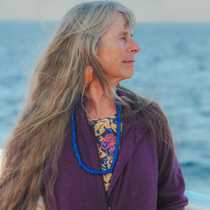Cruising Gulf of California, Hiking on Santa Catalina
As the sun approached the horizon, our Expedition Leader called everyone to the bow. It was well before sunrise and the National Geographic Sea Lion was cruising just south of Isla Santa Catalina, and slightly north of Isla Santa Cruz searching for marine mammals. As a gift on the first day of our voyage, a small pod of Short finned pilot whales made a slow approach towards the National Geographic Sea Lion. In a matter of minutes, one of the best displays of pajamas arrived on the bow to see our sunrise gift of not only Pilot whales, but also long beaked common dolphins!
The sun slowly rose in the east decorating the blows of these large and small dolphins as they began their early morning foraging for food. The Common dolphins cruised the surface of the sea while the Pilot whales rose to breathe and then made their customary deep dives in search of a breakfast of Humboldt squid.
Slowly the National Geographic Sea Lion pulled away from our early morning sightings of marine mammals and headed towards our morning destination of Isla Santa Catalina. Once our required boat drills were completed our ship’s crew began dropping Zodiacs and gear for our activities ashore on Isla Santa Catalina. Long, medium and leisurely photographers were all ferried ashore to spend time exploring one of the many unusual islands of the Gulf of California.
Santa Catalina is located approximately thirty miles off of the mainland of the Baja peninsula. Due to the distance off shore and the geologic formation of the island; i.e. emerging slightly after the rifting apart of the Baja peninsula from the mainland of Mexico, creating a different rock and soil content of great quantities of granite. This separation and soil content added to the development of several endemic species of animals and plants on the island. Accompanied by our natural history staff, we divided into groups and started a late morning journey up the island’s main arroyo looking for local and unusual inhabitants!
The island was decorated in several brightly colored Spring blooms. Palo verde shrubs were covered in yellow flowers, while two columnar cacti were crowned in very large blooms. The Cardon cacti had buds, cream-colored flowers and fruit along with the endemic Giant barrel cacti who sat in a very strange and extremely tall posture, topped with reddish-orange flowers. Radio chatter between naturalists began shortly after our hike began on land; a rattleless rattlesnake of unusual size had been spotted! Quickly several groups combined and more shouts were heard as several more snakes were spotted and within an hour three different color variations of this endemic snake species were seen, watched and photographed.
All too soon we were called back to the beach and began our Zodiac shuttles back to the National Geographic Sea Lion. Plans were changed and a decision was made to continue our search for marine mammals due to smooth seas and excellent conditions for spotting any activity on the surface.
The National Geographic Sea Lion headed west from her morning anchorage, in water like glass with fabulous visibility. Staff members working as spotters on the bow called many of us back to the bow shortly after lunch as a very rare species of marine mammal had been spotted in the distance. Kogia, a small marine mammal, can only be spotted in the glass-like conditions we had, and the sighting is always fleeting, and was again a reward to the most observant of our guests. This rare sighting inspired closer observation and very soon, two Blue whales were spotted in the distance.
As the National Geographic Sea Lion approached, our staff discussed the natural history of the largest mammal on the planet! Closer looks made it apparent that we were in the company of a cow calf pair, and it appeared that it was time for nursing! Again and again the mother whale would surface and just behind her a much smaller animal would position itself to receive milk from its mother.
It was only our first day aboard, and already we had been gifted with such a wonderfully diverse visual feast. The afternoon had become blisteringly hot, especially on the bow. With such wonderful conditions, our Expedition Leader and Captain decided to stop the National Geographic Sea Lion near the north end of Isla Carmen to cool off with a swim in the Gulf of California. The ship’s ladder was dropped and more squeals of delight could be heard as many a brave soul took a much needed plunge in the cooling waters of the Gulf of California.
Floating in the calm waters, looking out to the islands arranged like a necklace along the Baja peninsula, we were all just starting to understand the uniqueness of this desert by the sea.




